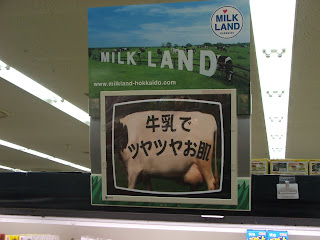Our first meeting on Wednesday morning was at the Hokuren Trading Company Offices. They began by giving an overview of Hokkaido agriculture. There are 59,000 farms on Hokkaido and 144 farmers’ union cooperatives, one for each prefecture. These are not cooperatives like the cooperatives in the U.S.; there are no dividends to producer members. Hokuren is the parent organization over all of these farmers’ cooperative unions. This seems to be somewhat like a combination of Farmland and Farm Bureau in a way. They have agricultural cooperatives, a bank, insurance and hospitals. They collect products from farmers and market them and they sell input products to farmers. They also seem to lobby on behalf of the farmers to the government, although when I asked who determines what positions they take on issues they said that is a good question. I never really got a good answer. There seemed to be a lot of communication and understanding problems in this meeting and it is very possible that I didn’t fully understand them. They said the cooperative association supports farmers in case of weather related losses and apparently the government subsidies are distributed through the farmers’ unions. When I asked about subsidies they said that the Ministry of Agriculture, Forestry and Fisheries has recently shifted from basing subsidies on each commodity to supporting farmers’ lifestyles. When I asked questions relating to trade policy they became very nervous and looked at each other to see who would answer. Out of the six people in the room really only one of them spoke very much. Basically they told me what I had heard before about free trade which is “Free trade is ideal” however they must protect the rice, wheat and dairy farmers because these are staple crops and their self sufficiency is already so low. This seems to be the official response. Despite the “Free Trade is Ideal” comment, I am pretty sure that one of the handouts they gave me tells people to support Japanese agriculture and something about the Australian (and maybe U.S.) EPA. It is printed in Japanese script and all I can read is EPA. The import tariff on one root vegetable product that we don’t have in the U.S. is as high as 990%. I guess the 100% tariff on beef and 210% tariff on wheat aren’t too bad compared to that. The government also controls all wheat trade and profits are at least partially redistributed to domestic producers. The government seems to have a lot of influence of the farmers’ production decisions. This is accomplished in a number of ways, including subsidies to not produce certain crops. Growers can use the land to produce some other crops but there are restrictions on which ones. This seems counter to becoming more self sufficient. Five years ago the government started requiring farmers to keep records on chemical use, farming systems, etc. and if consumers ask they must be told all of this information. Again very few, if any, really ask. Commodities are randomly tested for chemical residue. When BSE was first found in Japan the 100% testing program was started and it is very hard to back away from that now. They are very proud that Japanese food is considered very safe by other countries and this is an advantage when they do export something. The farmers’ cooperative unions on Hokkaido, and therefore Hokuren, are the strongest in Japan.
Next we went to lunch at a local crab restaurant. Hokkaido is known for its crab. We had dishes that included King Crab, Snow Crab and Hairy Crab. I had never had hairy crab before, it is sweet and delicious. I recommend it if you have a chance try it. One of the pictures below shows some hairy crabs in one of the groceries stores we visited later in the day. After lunch we went to a large grocery store in Sapporo, there was a much larger meat section in this store compared to the one in Tokyo and the packages were larger. They also eat a lot of lamb on Hokkaido, most of which is imported from Australia. The variety of items in their grocery stores amazes me. Next we went to a smaller grocery store that is owned by Hokuren, which specializes in domestically produced items. There isn’t as much variety in this store although it did have some imported products. Pictured below is some of the fresh mozzarella cheese from the plant that we visited on Tuesday. The other picture is a milk marketing advertisement video encouraging consumers to buy local milk. It was a very well produced video.



After the grocery stores we took the train to the airport and caught a flight back to Tokyo.




No comments:
Post a Comment